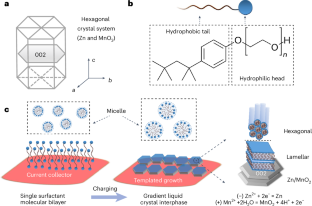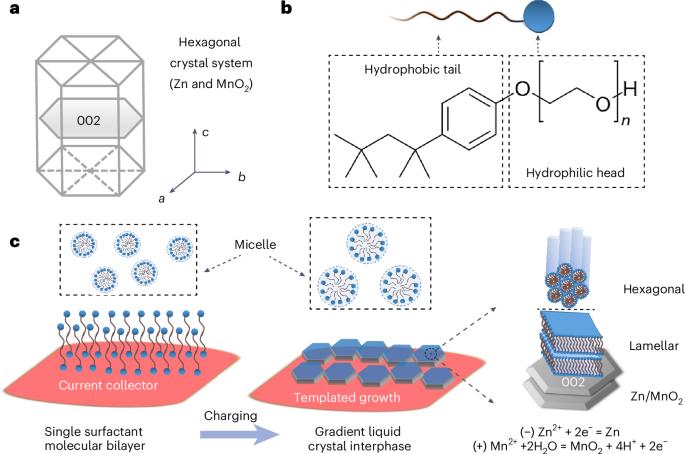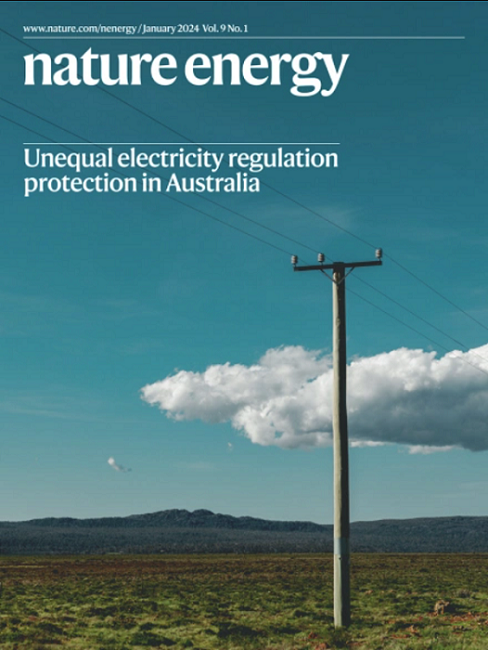In situ formation of liquid crystal interphase in electrolytes with soft templating effects for aqueous dual-electrode-free batteries
IF 49.7
1区 材料科学
Q1 ENERGY & FUELS
引用次数: 0
Abstract
Zn/MnO2 batteries, driven by a dual deposition reaction, are a prominent avenue for achieving high energy density in aqueous systems. Introducing an initially dual-electrode-free (anode/cathode) configuration can further boost energy density to over 200 Wh kg−1, but with limited cycle life due to the poor reversibility of Zn/MnO2 deposition and stripping. Drawing inspiration from soft templating strategies in material synthesis, here we apply this approach to electrodeposition and stripping by designing an in situ formed liquid crystal interphase. This concept is achieved by incorporating just 0.1 mM of surfactant molecules into the electrolyte, which induces favourable c-axis orientations in depositing both hexagonal Zn and MnO2. This enhancement subsequently increases the deposition/stripping reversibility and promotes the cycle life of the dual-electrode-free battery, achieving 80% capacity retention after ~950 cycles. This liquid crystal interphase chemistry also holds great promise for regulating deposition in other crystal systems, opening an exciting research direction for next-generation high-energy-density and long-duration energy storage based on aqueous chemistries. Achieving long-cycle-life, aqueous, dual-electrode-free Zn/MnO2 batteries with high energy density is challenging. This work introduces a liquid crystal interphase in the electrolytes with soft templating effects, considerably enhancing performance.


在电解质中原位形成具有软模板效应的液晶间相,用于水性无双电极电池
由双沉积反应驱动的锌/二氧化锰电池是在水性体系中实现高能量密度的重要途径。引入初始无双电极(阳极/阴极)配置可将能量密度进一步提高到 200 Wh kg-1 以上,但由于 Zn/MnO2 沉积和剥离的可逆性较差,因此循环寿命有限。我们从材料合成中的软模板策略中汲取灵感,通过设计一种原位形成的液晶中间相,将这种方法应用于电沉积和剥离。这一概念是通过在电解液中加入仅 0.1 mM 的表面活性剂分子来实现的,它能在沉积六方锌和二氧化锰时诱导有利的 c 轴取向。这种增强随后提高了沉积/剥离的可逆性,并延长了无双电极电池的循环寿命,在大约 950 次循环后实现了 80% 的容量保持率。这种液晶相间化学也为调节其他晶体系统中的沉积带来了巨大希望,为基于水化学的下一代高能量密度和长寿命储能开辟了令人兴奋的研究方向。
本文章由计算机程序翻译,如有差异,请以英文原文为准。
求助全文
约1分钟内获得全文
求助全文
来源期刊

Nature Energy
Energy-Energy Engineering and Power Technology
CiteScore
75.10
自引率
1.10%
发文量
193
期刊介绍:
Nature Energy is a monthly, online-only journal committed to showcasing the most impactful research on energy, covering everything from its generation and distribution to the societal implications of energy technologies and policies.
With a focus on exploring all facets of the ongoing energy discourse, Nature Energy delves into topics such as energy generation, storage, distribution, management, and the societal impacts of energy technologies and policies. Emphasizing studies that push the boundaries of knowledge and contribute to the development of next-generation solutions, the journal serves as a platform for the exchange of ideas among stakeholders at the forefront of the energy sector.
Maintaining the hallmark standards of the Nature brand, Nature Energy boasts a dedicated team of professional editors, a rigorous peer-review process, meticulous copy-editing and production, rapid publication times, and editorial independence.
In addition to original research articles, Nature Energy also publishes a range of content types, including Comments, Perspectives, Reviews, News & Views, Features, and Correspondence, covering a diverse array of disciplines relevant to the field of energy.
 求助内容:
求助内容: 应助结果提醒方式:
应助结果提醒方式:


